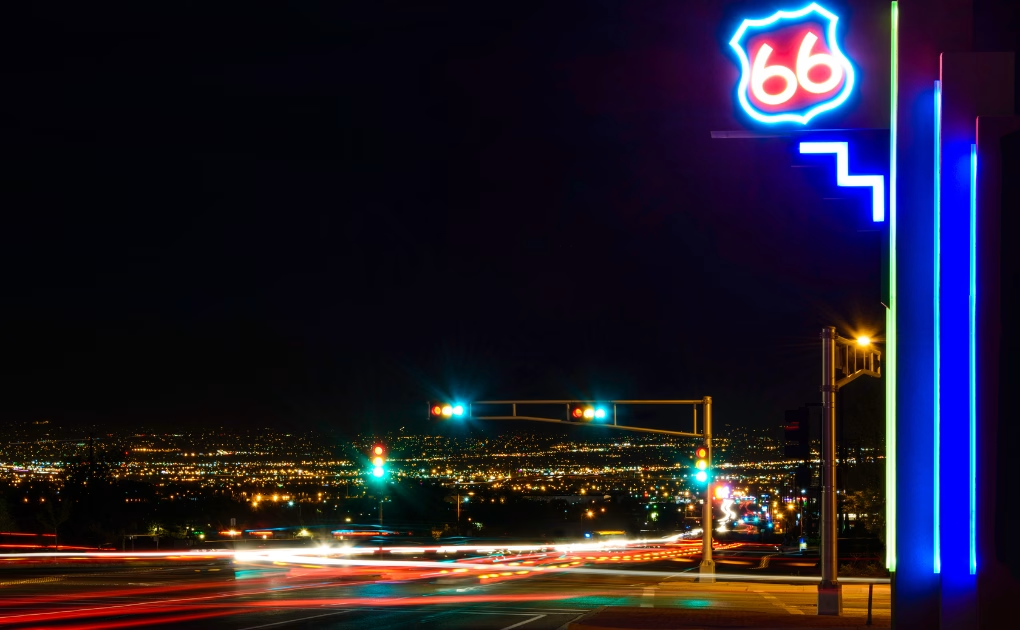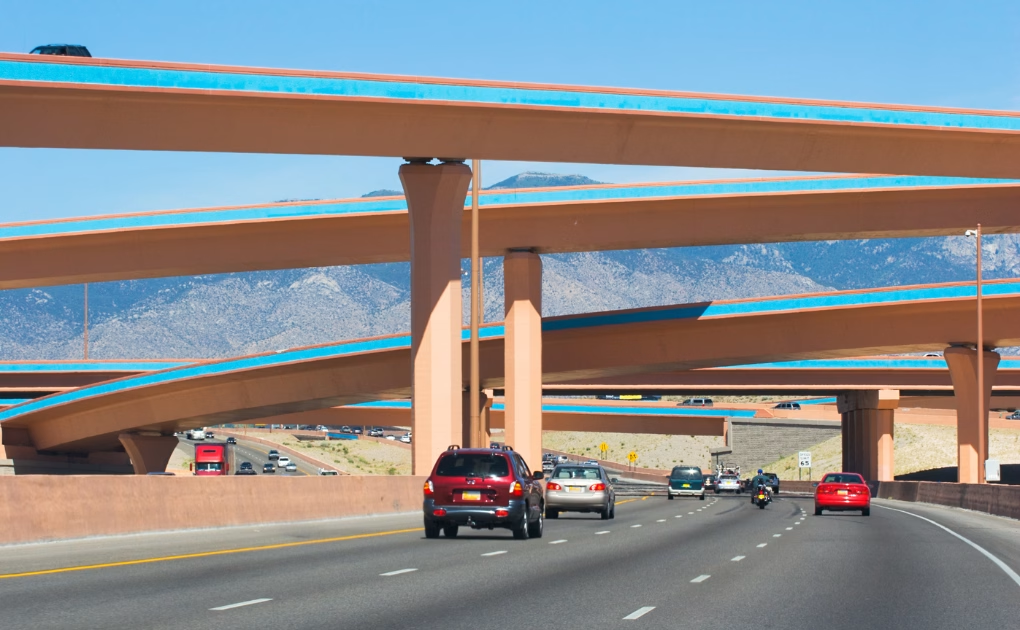How Route 66 Built Albuquerque’s Tourism and Cultural Landscape
Did you know that a single highway transformed Albuquerque into a cultural hotspot? Route 66, often called the “Main Street of America,” wasn’t just a road. It was a gateway to adventure, commerce, and connection.
Stretching from Chicago to Los Angeles, Route 66 connected travelers to America’s varied landscapes and cultures, with Albuquerque serving as a key stop along the way.
For decades, Route 66 turned Albuquerque into a must-visit destination, welcoming road trippers with neon signs, retro diners, and the unmistakable charm of the Southwest. Even today, its legacy lives on, drawing visitors eager to experience a slice of history. Let’s explore how this legendary highway shaped Albuquerque and why it is essential to the city’s identity.
What Made Route 66 So Special?

Route 66 wasn’t just another road—it was a 2,448-mile lifeline connecting the Midwest to the West Coast, crossing eight states and revolutionizing travel in the early 20th century.
Built in 1926, it became a symbol of freedom and exploration as car culture took off. The highway brought a sense of adventure, dotted with roadside diners, quirky attractions, and gas stations that made long journeys feel exciting and accessible.
Known as the “Main Street of America,” Route 66 played a key role in fostering local economies and shaping American culture. It wasn’t just a way to get from one place to another—it was a stage for neon signs, vintage motels, and unique pit stops that captured the spirit of the times. This highway represented progress, connection, and the simple joy of a road trip.
Though decommissioned in 1985, Route 66 remains a symbol of progress, connection, and the simple joy of the American road trip.
Albuquerque’s Perfect Spot on the Map
Albuquerque’s location made it a natural stop along Route 66. Nestled in the Southwestern desert, the city offered both convenience and culture to road-trippers. Its proximity to breathtaking landmarks like the Sandia Mountains and the Rio Grande gave travelers scenic views and a reason to linger.
Beyond its geography, Albuquerque stood out for its unique cultural blend of Native American, Hispanic, and Anglo influences. Visitors could enjoy vibrant art, traditional cuisine, and a welcoming atmosphere that made the city feel both distinctive and familiar.
Albuquerque wasn’t just a waypoint it was an experience in itself, drawing people in with its rich heritage and Southwestern charm.
How Route 66 Transformed Albuquerque’s Economy
Route 66 brought more than just travelers to Albuquerque, it brought prosperity. The highway spurred a boom in local businesses, with motels, diners, and gas stations thriving along its path.
Iconic spots like the El Vado Motel became more than places to stay—they were destinations where travelers could enjoy Albuquerque’s unique style and hospitality. Central Avenue, which follows the route of Route 66 through the city, became the lifeline of Albuquerque’s economy.
Its neon signs, retro architecture, and bustling atmosphere reflected the energy Route 66 brought to the city. The steady stream of road trippers helped Albuquerque grow into a vibrant urban center, with Route 66 serving as a foundation for its economic success. Today, the legacy of this boom is still visible in the preserved landmarks and vintage charm of Central Avenue.
Local Icons of Route 66
Albuquerque is home to many landmarks that keep the spirit of Route 66 alive. The KiMo Theatre, with its unique Pueblo Deco design, stands as a cultural treasure and a testament to the city’s architectural creativity. Central Avenue, the modern face of Route 66, is lined with reminders of its past, from historic motels to colorful neon signs that light up the night.
The city’s history is also reflected in its murals and artwork, celebrating Route 66’s impact on Albuquerque’s identity. These landmarks aren’t just relics—they’re vibrant parts of the city’s present, inviting visitors to connect with a time when the open road symbolized endless possibilities.
The Fall and Revival of Route 66 Tourism

The rise of the Interstate Highway System in the mid-20th century marked a turning point for Route 66. As faster, more direct routes became available, traffic on Route 66 dwindled, leaving many businesses and communities struggling to stay afloat. Albuquerque, once a bustling hub for travelers, felt the impact as motels, diners, and gas stations began to close.
However, Route 66 never truly disappeared. In recent decades, preservation efforts have brought new life to the historic highway. Albuquerque has embraced its Route 66 heritage, restoring neon signs, revitalizing Central Avenue, and hosting events to celebrate its significance.
These initiatives have not only honored the past but have also made Route 66 a key part of Albuquerque’s modern tourism industry, drawing visitors eager to experience its history and charm.
Festivals and Events That Celebrate Route 66 in Albuquerque
Albuquerque keeps the spirit of Route 66 alive through a variety of celebrations. Events like the Route 66 Summerfest unite the community with live music, food vendors, and family-friendly activities. Historic walks and tours offer a deeper dive into the stories and landmarks that make Route 66 so special, allowing visitors to connect with the city’s rich history.
Why Route 66 Still Matters Today
Route 66 is more than a piece of Albuquerque’s past—it’s a cornerstone of its identity. Organizations like the Route 66 Association of New Mexico work tirelessly to preserve the highway’s landmarks and cultural significance, ensuring its legacy remains alive.
Through restoration efforts and community events, they highlight the stories and traditions that make Albuquerque’s connection to Route 66 unique. By keeping this history alive, the city ensures that future generations can experience the magic and impact of the iconic highway.
How to Experience Route 66 in Albuquerque
Exploring Route 66 in Albuquerque is a must for anyone looking to dive into the city’s history and culture. Here are some tips to make the most of your journey along this iconic stretch:
- Start on Central Avenue. This is the heart of Albuquerque’s Route 66. Walk or drive along to discover restored neon signs, vintage motels, and landmarks like the historic KiMo Theatre.
- Stop at the 66 Diner. Step back in time with retro decor and enjoy classic diner fare in this nostalgic spot.
- Seek out hidden gems. Keep an eye out for colorful murals, vintage shops, and other unique spots that showcase Albuquerque’s charm and connection to Route 66.
Whether it’s your first visit or you’re rediscovering the city, exploring Route 66 is a memorable way to experience Albuquerque’s unique blend of history and culture.
The Lasting Impact of Route 66 on Albuquerque
Route 66 is more than a highway—it’s a key part of Albuquerque’s history, shaping its economy, culture, and identity. Exploring Route 66 reveals how the city honors its past while embracing the future.
The landmarks along the way, from neon signs to historic motels, tell stories of a vibrant era that still inspires. For Albuquerque, Route 66 isn’t just history; it’s a living link to its heritage. Preserving it ensures future generations can experience its unique character and history.
Rediscover the magic of the open road—start your Route 66 journey in Albuquerque today! Support preservation by donating to the Route 66 Association or joining local events to keep this iconic highway alive.
